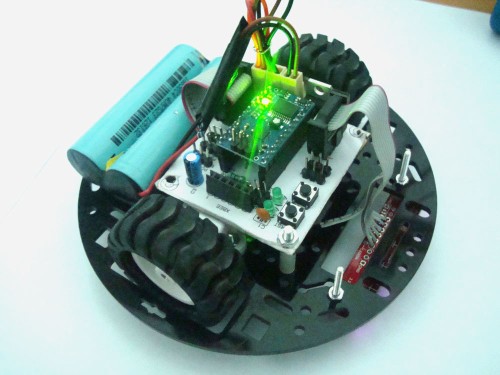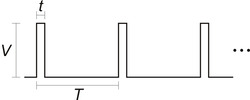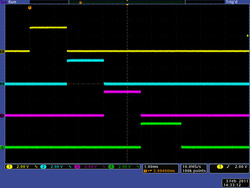Pololu Blog »
Pololu Blog (Page 89)
Welcome to the Pololu Blog, where we provide updates about what we and our customers are doing and thinking about. This blog used to be Pololu president Jan Malášek’s Engage Your Brain blog; you can view just those posts here.
Popular tags: community projects new products raspberry pi arduino more…
Build Yourself a Bluetooth Controlled Six-Legged Robot
This small hexapod using the Micro Maestro is controlled remotely using a Bluetooth module. Very detailed build information is available in this blog post.
Simple hardware approach to controlling a servo
For the last several posts, I have been writing about how hobby servos work and demonstrating the operation of devices made for controlling servos, such as RC receivers and serial servo controllers. That should have given you a good idea of the kinds of control signals we must create if we are to control servos with our own hardware. Today, I am moving on to the subject of controlling servos ourselves, and I will begin with a simple hardware approach. Continued…
Only5 - general-purpose, high-performance robot
 |
Only5 is designed to be a general-purpose, high-performance robot. It uses many Pololu parts including the Pololu 5" Robot Chassis RRC04A and the Baby Orangutan robot controller. For more information see the project page.
Here is a short video showing its impressive speed:
Instructable Groovin' Grover: a microcontroller-based marionette
Groovin’ Grover is a marionette manipulated by four hobby servos and a Pololu Maestro servo controller. You can control each of Grover’s limbs independently and make him walk, wave, and – most entertainingly – make him dance. Groovin’ Grover is easy to assemble and wire up. This Instructable explains how to build your own Groovin’ Grover.
Servo control interface in detail
Last time, I gave a basic introduction to the simple pulse interface for sending commands to servos. In this post, I want to explore some of the details and ramifications of the servo interface in a bit more depth. I’ll be using the Mini Maestro 12-channel servo controller, which offers a lot of servo control flexibility, and a current probe with my oscilloscope to illustrate servos’ responses. Continued…
Robot Zero: a fast line follower for beginners
This excellent guide from C.I.r.E. (Club de Informática, robótica y Electrónica) shows in detail how to build a fast (> 2 m/s) line-following robot from scratch, and it makes use of a number of Pololu products.
Home-made m3pi robot controlled by Bluetooth keyboard
This project by Kazuhiro Ouchi (in Japanese) shows a 3pi robot with an ARM mbed controlled by Bluetooth keyboard.
Electrical characteristics of servos and introduction to the servo control interface
So far, I have been talking about servos largely from the perspective of their typical use. While I hope I have provided a decent foundation about their intended use and some idea of what is inside a servo, these are things you could learn from hobby stores and taking apart a few servos. Today, I want to move on to a discussion of the electrical characteristics of servos, with the control interface as the primary topic. From the servo manufacturers’ perspective, the control signal can be an internal detail, so discussing it means we are moving on to a realm that is less officially documented. I will try to keep things general and back up my claims a bit where practical, but some details might not apply to all servos. Continued…
Snow-Boarduino 4WD robot
 |
We found this robot pictured on the Adafruit forums driving through some snow. It was made with a TReX, a 4WD Wild Thumper, and a Boarduino.
Servo, servo motor, servomotor (definitely not server)
Now that the cat’s out of the bag about RC servos having motors inside (it was a very transparent bag), it’s appropriate to emphasize that servos are not “servo motors” and that “servo” is not short for “servomotor”. Servo is short for “servomechanism”, whereas servo motors are motors intended to be used in servos. It’s important to understand the distinction because we should care about names and communicating well; making the distinction between the terms will also help emphasize why servos are so special. Continued…
































